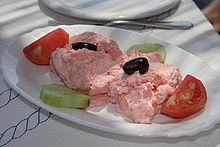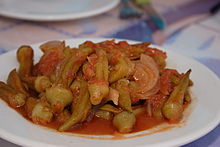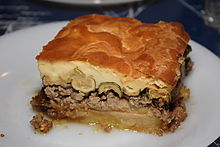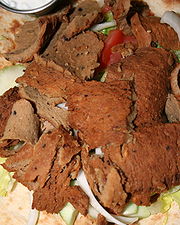- Cypriot cuisine
-
Bamies(okra with tomato and oil)

Cypriot cuisine is the cuisine of Cyprus and can be described as a blend of Greek cuisines. Greek Cypriot cuisine is another regional Greek cuisine along with Cretan, Ionian, or Attic. Modern western cuisine (especially fast food) has an increasing influence on the day-to-day diet on the island. The names given to the foods of the Cypriot cuisine are different amongst the dominant population,the Greeks.
Contents
Food preparation
Food for Cypriots means a feast. Frequently used ingredients are fresh vegetables such as courgettes, green peppers, okra, green beans, artichokes, carrots, tomatoes, cucumbers, lettuce and grape leaves, and pulses such as beans (for fasolia), broad beans, peas, black-eyed beans, chick-peas and lentils. Pears, apples, grapes, oranges, mandarines, nectarines, mespila, blackberries, cherry, strawberries, figs, watermelon, melon, avocado, citrus, lemon, pistachio, almond, chestnut, walnut, hazelnut are some of the commonest of the fruits and nuts.
The best-known spices and herbs include pepper, parsley, roka, celery, thyme, and oregano. Traditionally, artisha (cumin) and kolyandro/kolliandros (coriander) seeds make up the main cooking aromas of the island. Mint is a very important herb in Cyprus. It grows voraciously, and locals use it for everything, particularly in dishes containing ground meat. For example, the Cypriot version of pastitsio (locally known as macaronia tou fournou) contains very little tomato and generous amounts of mint. The same is true of keftedes (meat balls,which are sometimes laced with mint to provide a contrast with the meat.
Cypriots grill over charcoal. The famous souvla. They grill halloumi cheese, olives, mushrooms and loukaniko (pork sausages).These are souvlaki,sheftalia, or gyros.Gyros is made from various cuts of lamb, pork, or occasionally chicken, and very rarely beef. They are typically served stuffed into a pitta pocket or wrapped in a thin flatbread, along with a salad of cabbage, parsley, and raw mild onions, tomatoes and sliced cucumber.Gyros is grilled meat slices instead of chunks, and the taste is made different by the salad or dressings added.
Pourgouri is the traditional carbohydrate other than bread. It is steamed with tomato and onion; a few strands of vermicelli pasta are often added to provide a texture contrast. Along with pourgouri, natural yoghurt is a staple. Wheat and yoghurt come together in the traditional peasants' breakfast of tarhana/trahanas, a primitive form of pasta, in which the cracked wheat is steamed, mixed with sour milk, dried, and stored. Small amounts reheated in water or broth provide a very nourishing and tasty meal, especially with added cubes of well-aged halloumi.Pourgouri is also used to make koupes where the bulgur/pourgouri is mixed with flour and water to form a dough, which is formed into a cigar shape. A hollow is made through the cigar and a mixture of minced meat, onions, parsley and cinnamon is packed. After sealing the meat mixture inside the cigar they are deep-fried before serving with lemon juice.For Greek Cypriots, there are many fasting days imposed by the Greek Orthodox Church, and though not everyone adheres, many do. On these days, effectively all animal products must not be consumed. Pulses are eaten instead, sometimes cooked in tomato sauce (yiahni in greek) but more usually simply prepared and dressed with olive oil and lemon. On some days, even olive oil is not allowed. These meals often consist of raw onion, raw garlic, and dried red chiliis munched along with these austere dishes to add a variety of taste, though this practice is dying out.
Meals
Seafood
Popular seafood dishes include calamari, octopus, cuttlefish, red mullet parpouni, sea bass lavraki, and gilt-head bream (chipura/tsipoura).[1] Octopus, due to its robust nature, is made into a stiffado (stew) with red wine, carrots, tomatoes, and onions. Calamari is either cut into rings and fried in batter or is stuffed whole with rice, cumin, cloves, sometimes adding mint to the stuffing, and then baked or grilled. Cuttlefish (soupies) may be cooked like calamari or like octopus in red wine with onions. It is sometimes prepared with spinach, but without adding garden peas, which are a popular accompaniment for cuttlefish in Turkey, specially in west and south coast, some parts of Greece and Italy. Calamari, octopus, and cuttlefish commonly feature in meze, a spread of small dishes served as an appetizer or a meal.
The most traditional fish is salt cod, which up until very recently was baked in the outdoor beehive ovens with potatoes and tomatoes in season. Gilt-head bream is popular because it is relatively inexpensive and like sea bass extensively farmed. Until recently, salted herrings bought whole out of wooden barrels were a staple food. They are still enjoyed, but not as much now, as fresh fish and meat are regular alternatives.
Vegetables
Cyprus potatoes are long and waxy with a unique taste, exported internationally. Locals love them baked in the oven, preferably the outdoor beehive fourni. Many Cypriots add salt, cumin, oregano, and some finely sliced onion. When they barbecue, some Cypriots put potatoes into foil and sit them in the charcoal to make them like jacket potatoes - served with butter and/or as a side dish to salad and meat.
Salad vegetables are eaten at every meal, sometimes whole. More often, they are prepared chopped, sliced, and dressed with lemon and olive oil. In the summer, the usual salad is of celery leaves and stalks, parsley, coriander leaves, tomatoes, and cucumber. Summer purslane is very popular as are wild dandelion leaves.
In the early spring, artichokes are in season. Cypriots eat the leaves by detaching and bitting off the fleshy base. A common preparation for the stalks and the heart is braised with garden peas, with a little onion and perhaps a chopped tomato. Meat is sometimes added.
Bamies (okra or ladies' fingers) are baked in the oven with tomato and oil, and kounoupidhi (cauliflower) is also given this treatment. Cauliflower is also made into moungra, a sour pickle covered with a marinade of vinegar, yeast, and mustard seeds. It is also cooked in tomato sauce, onions and mince meat.
Vazania (aubergines) can be prepared in a variety of ways, including stuffed and in moussaka. They are commonly fried and stewed slowly in oil, where the cooking time brings out the flavour and also allows them to shed the oil they have absorbed. Turkish cypriots hollow them, fry them, stuff them with tomatoes and garlic or mince meat and tomato paste, cook them in the oven and garnish with parsley.
Meat
 Meat meze with sliced luntza, chiromeri, onions and olives
Meat meze with sliced luntza, chiromeri, onions and olives
Being only a very recently urbanized country, Cypriots traditionally ate fresh meat on weekends. This was usually a boiled chicken, served with a starch (maybe pasta, maybe pourgouri) cooked in its juices. This would stretch the meat to enable the whole family to eat. Other fresh meat dishes were only enjoyed occasionally, sometimes en masse as a feast such as a wedding. Now, as people are better off and meat is widely available, traditional meat dishes are enjoyed frequently.
Afelia, when well prepared, is a delicious saute of pork, red wine, and coriander seeds. Psito is large chunks of meat and potatoes cooked in the oven. Plenty of fat is used in its preparation; traditionally, this would have been rendered pig fat, but now sunflower oil is used. Olive oil is used as a dressing for salads, vegetables, and pulses but is not used to cook meat dishes.
Preserved pork meat is very popular, and before refrigeration, it was the main source of red meat available to Greek Cypriots. Cypriots also add red wine; therefore, there is a characteristic flavour to most of the charcuterie from the island.
Lountza is made from the pork tenderloin. After the initial brining and marinading in wine, it is smoked. Although it can be aged, many prefer younger, milder lountza. It is often cooked over coals or fried with eggs to act as a sandwich filler or as part of a meze. Stronger than lountza and made from the leg, is chiromeri, which is similar to any smoked, air-dried ham from Southern Europe, although the wine flavour makes it characteristically Cypriot. In non-mountain areas, the same meat used for chiromeri is cut into strips along the muscle compartments and dried in the sun as basta. The shoulder of a freshly slaughtered animal is cut into chunks about the size of an almond along with a smaller quantity of chopped back fat, which are marinated in wine and brined, stuffed into intestines, and smoked as sausages (loukaniko). The Italians have a sausage of the same name.
A traditional practice that is dying out fast is to render pig fat for use as a cooking medium and a preservative. Loukaniko and also chunks of fried salted pork meat and fat can be stored in earthenware jars submerged in the lard for a long time, even in the heat of the island. Koupes is the Island's variant of what is called Kouba in the Arabic world. It's made from a burghouri grain exterior which is molded into a spherical shape and filled with a mince and onion mixture. The variation from the Arabic version is that the Cypriots use pork instead of beef, as well as the spices. You can find these in any bakery, which would be made fresh in the morning. However for the best Koupes you have to have it straight from the frier! For this you need to visit local pastry shops that will make it for you on order. See below links for some of these.
Lamb and goat meat is also preserved as tsamarella, made very salty to prevent the fatty lamb meat from going rancid. Very popular amongst both communities is preserved beef. The whole silversides and briskets are salted and spiced quite powerfully to make pastourma. The same meat and some fat is chopped finely and made into pastourma-loukaniko sausages.
Many Greek Cypriots consider snails a delicacy. Snails are in season in late autumn, when the first good rains arrive after the hot summer. After being purged, they are either prepared as a pilaf with rice, or cooked in cinnamon, onions and tomatoes as a stifado.
Mezedes
 Taramosalata, a fish roe dip
Taramosalata, a fish roe dip
Mezedes is a large selection of dishes with small helpings of varied foods, brought to the table as a progression of tastes and textures. The meal begins with black and green olives,tahini, skordalia (potato and garlic dip), humus, taramosalata (fish roe dip), and tzatziki, all served with chunks of fresh bread and a bowl of mixed salad. Some of the more unusual meze dishes include octopus in red wine, snails in tomato sauce, brains with pickled capers, samarella (salted dried meat), quails, pickled quail eggs, tongue, ram's testes, kappari pickles (capers), and moungra (pickled cauliflower). Bunches of greens, some raw, some dressed with lemon juice and salt, are a basic feature of the meze table. The meal continues with fish, grilled halloumi cheese, lountza (smoked pork tenderloin), keftedes(minced meatballs), sheftalia (pork rissoles), and loukaniko (pork sausages). Hot grilled meats – kebabs, lamb chops, chicken – may be served toward the end. The dessert is usually fresh fruit or glyka – traditional sugar-preserved fruits and nuts.[2]
Desserts
Loukoumades(fried doughballs in syrup), Loukoumia, Ravani,Touloumbes,Baklavas are some of the loved desserts. There is also Pastish, a cookie made of ground almonds that are offered to guests at weddings.
Flaounes are savory Easter pies that contain goats cheese (or a variety of cheeses), eggs, spices and herbs all wrapped in a yeast pastry, then brushed with egg yolk and dipped into sesame seeds.[3]
Cypriots also make many traditional sweets that are usually made of turunch/ bergamot, figs, tiny aubergines, fresh fleshy walnuts, watermelon or pumpkins processed akin to jam but without the over-cooking. The fruit is soaked for two weeks (depending upon the fruit) then boiled with sugar until the correct texture is obtained.
Cheeses
 Anari cheese served for breakfast in a Limassol hotel
Anari cheese served for breakfast in a Limassol hotel
Halloumi is a semi-hard white-brined cheese with elastic texture, made in a rectangular shape from a mixture of goat and sheep milk; it may be sliced and eaten fresh, grilled, or fried. Aged halloumi may be grated over pasta dishes. It is the national cheese of Cyprus.
Anari, from Greek (αναρή) is a crumbly fresh whey cheese, similar to ricotta, made from goat or sheep milk. Usually unsalted (though salted versions are available), it is sometimes eaten with a drizzle of honey or carob syrup.
Drinks
 Commandaria wine region at the map
Commandaria wine region at the map
Non alcoholic
Ayrani is a traditional drink made of milk. Its recipe varies from region to region. Triantafyllo, a thick concentrated dark pink syrup (en: Rose cordial) made from the extract of the Cyprus (Damascus) rose, has water or milk added to make a refreshing sweet cordial, especially in summer. It is distinct from rodostagma (lit. rose drops) (rose water) and anthonero (blossom water), which are clear liquids, are used to sweeten machalepi and other sweetmeats.
Alcoholic
Among Cypriots traditional Brandy and Zivania are of the most popular drinks on the island. The second popular drink is beer. The local breweries of KEO and Carlsberg command the lion's share of the market. In the Turkish-controlled areas, Efes is the most widely sold. Evidence of wine production on Cyprus —one of the first wine producers— goes back for millennia. Commandaria, the oldest wine in continuous production, is a popular dessert wine.
Cyprus also has a tradition of brandy production, with production by various Limassol-based distilleries since 1871. Cypriot brandy is commonly drunk with meze dishes, and forms the base for the distinctive brandy sour cocktail, developed on the island in the late-1930s. Zivania, a grape distillate similar to raki, is another popular spirit.
See also
References
- ^ Common names of fish from fishbase.org
- ^ Cypriot mezedes, Cyprus Tourism Organisation web site
- ^ Finding Flaounes
External links
Cuisine of Cyprus Mezedhes Cheeses Dishes Afelia · Ambelopoulia · Avgolemono · Couscous · Fried eggplant · Fasolada · Gyros · Keftedhes (Kuftah) · Kléftiko · Koupepia (Dolmades) · Macaronia tou Fournou · Moussaka · Moukentra (Mujaddara) · Pastourma · Pilafi · Sheftalia · Souvla · Souvlaki · Stuffed Marrow · Tavvas (Tajine) · Tsamarella · YahniDesserts Baklava · Flaounes · Gliko · Halvas · Kothropita · Koupes · Lâpa · Loukoumades · Loukoumi (Turkish/Cyprus Delight) · Mahlab · Soutzoukos · Tiropita · Tsoureki · TulumbaDrinks Ayrani · Commandaria · Brandy Sour · Cypriot coffee · Cyprus brandy · Cyprus wine · Frappé coffee · Triantafylon (Rose syrup) · ZivaniaAsian cuisine Sovereign
states- Afghanistan
- Armenia
- Azerbaijan
- Bahrain
- Bangladesh
- Bhutan
- Brunei
- Burma (Myanmar)
- Cambodia
- People's Republic of China
- Cyprus
- East Timor (Timor-Leste)
- Egypt
- Georgia
- India
- Indonesia
- Iran
- Iraq
- Israel
- Japan
- Jordan
- Kazakhstan
- North Korea
- South Korea
- Kuwait
- Kyrgyzstan
- Laos
- Lebanon
- Malaysia
- Maldives
- Mongolia
- Nepal
- Oman
- Pakistan
- Philippines
- Qatar
- Russia
- Saudi Arabia
- Singapore
- Sri Lanka
- Syria
- Tajikistan
- Thailand
- Turkey
- Turkmenistan
- United Arab Emirates
- Uzbekistan
- Vietnam
- Yemen
States with limited
recognition- Abkhazia
- Nagorno-Karabakh
- Northern Cyprus
- Palestine
- Republic of China (Taiwan)
- South Ossetia
Dependencies and
other territoriesEuropean cuisine Sovereign
states- Albania
- Andorra
- Armenia
- Austria
- Azerbaijan
- Belarus
- Belgium
- Bosnia and Herzegovina
- Bulgaria
- Croatia
- Cyprus
- Czech Republic
- Denmark
- Estonia
- Finland
- France
- Georgia
- Germany
- Greece
- Hungary
- Iceland
- Ireland
- Italy
- Kazakhstan
- Latvia
- Liechtenstein
- Lithuania
- Luxembourg
- Macedonia
- Malta
- Moldova
- Monaco
- Montenegro
- Netherlands
- Norway
- Poland
- Portugal
- Romania
- Russia
- San Marino
- Serbia
- Slovakia
- Slovenia
- Spain
- Sweden
- Switzerland
- Turkey
- Ukraine
- United Kingdom
- (England
- Northern Ireland
- Scotland
- Wales)
- Vatican City
States with limited
recognition- Abkhazia
- Kosovo
- Nagorno-Karabakh Republic
- Northern Cyprus
- South Ossetia
- Transnistria
Dependencies
and other territories- Åland
- Faroe Islands
- Gibraltar
- Guernsey
- Jan Mayen
- Jersey
- Isle of Man
- Svalbard
Cuisine of the Mediterranean Northern Africa Southern Europe European regions Western Asia Categories:
Wikimedia Foundation. 2010.





